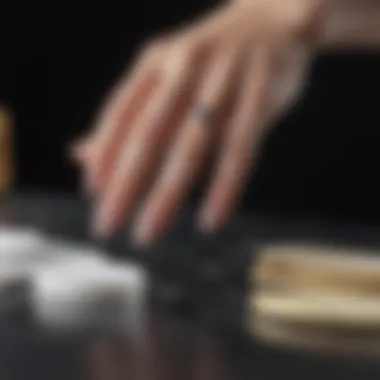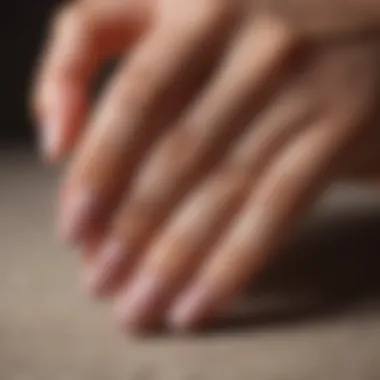Effective Methods for Safe Gel Polish Removal


Intro
Gel polish is a popular choice for many who appreciate its durability and glossy finish. However, when the time comes to remove it, the process can often be daunting. Knowing the right methods to take it off safely can make a significant difference to nail health. Understanding these methods not only protects your natural nails from damage but also ensures that your hands continue to look well-groomed.
In this article, we will delve into effective techniques for removing gel polish. We will explore necessary tools and products, as well as aftercare strategies to protect your nails post-removal. Each step will be outlined clearly to provide you with a comprehensive knowledge base.
The process of gel polish removal does not have to be complicated. By following precise methods, you can achieve a clean removal while preserving the strength and integrity of your nails. This is especially relevant for those who frequently use gel polish and may experience weakening over time.
Ultimately, the goal is to empower you with both the information and the confidence to perform gel polish removal effectively at home. Let's begin by exploring the initial approach to removing this type of polish.
Understanding Gel Polish
Understanding gel polish is essential for anyone looking to remove it safely and effectively from their fingernails. Gel polish has gained popularity due to its long-lasting nature and glossy finish. However, this durability also makes its removal a different process when compared to regular nail polish. By grasping the characteristics of gel polish, one can prepare adequately for the removal process and minimize potential damage to the natural nail.
This section serves as a foundation for the rest of the article. Insights into the composition and differences between gel and regular nail polish will be crucial. Only with this understanding can individuals appreciate the methods available for gel polish removal; hence, it is important to delve deeper into what gel polish truly is and how it behaves once applied.
Composition of Gel Polish
Gel polish is a blend of ingredients that create its unique properties. Typically, it consists of:
- Polymer Resins: These provide the strong structure that makes gel polish resilient.
- Color Pigments: These give the polish its vibrant hues.
- Photoinitiators: These chemicals react to UV light to polymerize and cure the polish, resulting in the hard finish.
The combination of these elements contributes to the polish's longevity, often lasting weeks without chipping. However, this very strength complicates the removal process, as the polish adheres firmly to the nail surface.
Difference Between Gel and Regular Nail Polish
Although both products serve a similar purpose in enhancing nail aesthetics, there are significant differences between gel polish and traditional nail polish:
- Curing Process: Gel polish requires exposure to UV or LED light to set, while regular polish air dries. This curing method is why gel polish can last longer.
- Durability: Gel polish is resistant to chipping and fading, which is one of its main attractions. Regular polish, however, tends to wear off more quickly.
- Removability: Gel polish necessitates specific removal techniques, often involving soaking or filing. In contrast, regular nail polish can be easily wiped off with acetone or non-acetone removers.
- Finish: Gel polish typically offers a glossier and thicker finish compared to the more matte appearances of some regular polishes.
Overall, understanding these differences can guide users in selecting the right polish for their needs and set realistic expectations regarding the removal process.
Tools Required for Removal
Removing gel polish effectively is more than just following the removal steps; it involves having the right tools. The right tools not only make the process smoother but also help in preserving the health of your nails. Using incorrect or inadequate tools can result in nail damage, which is a primary concern for many. This section will outline the necessary products and implements to ensure a successful gel polish removal experience without harming your nails.
Essential Nail Care Products
Choosing the right nail care products is fundamental in the gel polish removal process. One must consider a few key items:
- Acetone or Gel Polish Remover: Acetone is often considered the most effective solvent for dissolving gel polish. If using a non-acetone remover, ensure it is specifically designed for gel polish; otherwise, it may not work effectively.
- Cotton Balls or Pads: These should be absorbent and soft to avoid scratching the surface of the nails. They will be essential for soaking in the remover and applying it directly onto the gel polish.
- Aluminum Foil: When using the soaking method, small pieces of aluminum foil are necessary to secure the cotton balls in place. This creates a confined space for the remover to work more effectively.
- Nail Oil or Moisturizer: After the removal process, it is important to hydrate your nails and surrounding skin. Nail oil can also help to restore durability and shine.
Using these essential products greatly increases the likelihood of a smooth removal process. Conversely, using products that are not suited for gel polish can lead to frustrations and potential damage.
Recommended Implements
In addition to quality nail care products, having the right implements is equally important. Here are some recommended tools that will assist in the gel polish removal process:
- Nail File: A coarse nail file is useful for gently filing the top layer of the gel polish. This helps in breaking the seal and allows the remover to penetrate more effectively.
- Cuticle Pusher: A wooden or metal cuticle pusher can help lift any remaining gel polish once it has been soaked. Ensure to use it gently to avoid damaging the nail bed.
- Buffers: Buffers can smooth out the nail surface once the gel polish is removed, which enhances the appearance of natural nails.
- Tweezers: These can assist in grasping the foil after removing polish. It keeps the hands steady and helps in cleanup.
Ensuring that these tools are ready and accessible will aid in creating an efficient workflow during the removal process.
"Effective nail care tools are an investment in maintaining healthy and beautiful nails."


Having the right tools not only simplifies the removal process but also significantly reduces the risk of potential nail damage.
Preparing for the Removal Process
Preparing for the removal of gel polish is a critical step that often dictates the effectiveness and safety of the entire process. Before diving into the actual removal techniques, taking the time to prepare can lead to a smoother experience and help in achieving healthier nails post-removal. Proper preparation involves evaluating the health of your nails and establishing an organized workspace. Both elements are essential not only for ensuring the effectiveness of the removal methods but also for minimizing the risk of damage to the natural nail.
Assessing Nail Health
Assessing the health of your nails is paramount. This step helps in determining if your nails are ready for gel polish removal. Look for signs of damage, such as brittleness, discoloration, or peeling. If your nails exhibit these symptoms, it may be wise to hold off on removal until your nails recover. Staying aware of these indicators can ensure that you do not exacerbate any existing problems during the removal process. Healthy nails can sustain the removal process better without suffering further damage. Remember that overexposure to gel polish can also lead to weakness.
- Look for the following signs:
- Consider applying a nourishing nail oil or conditioner prior to the removal process if your nails seem damaged.
- Brittleness
- Peeling or splitting
- Yellowish tint
Setting Up Your Workspace
An organized workspace can enhance the efficiency of the removal process. Gather all the necessary tools and materials before starting. This will minimize distractions and reduce the chances of interruptions.
Some key elements to consider:
- Clear Surface: Make sure your working area is clean and well-lit. A clutter-free space helps you focus on the task at hand.
- Tools Readiness: \Ensure all needed tools, like acetone, cotton balls, and nail files, are within arm's reach. This readiness streamlines the process and reduces the stress of searching for misplaced items.
- Comfort: Choose a comfortable seat that supports a relaxed posture. This will make the process more enjoyable and less cumbersome.
A well-prepared workspace contributes significantly to both the effectiveness of the nail removal process and the well-being of your nails.
Taking these preparatory steps helps streamline the removal of gel polish, promoting a better overall experience. Investing time into preparation will likely yield positive results, protecting your nails and ensuring that the removal process is carried out as efficiently as possible.
Step-by-Step Removal Techniques
Removing gel polish is a process that requires careful attention to detail. This section will discuss various techniques to effectively remove gel polish without damaging the natural nail. Utilizing correct methods is vital to ensure a safe removal experience. Each technique brings its own benefits and considerations that should be understood before proceeding.
Soaking Method
The soaking method is one of the most commonly used techniques for gel polish removal. It involves soaking cotton balls or pads in acetone, applying them to the nails, and wrapping them in foil. This method softens the gel polish, making it easier to remove without excessive buffing or filing.
Benefits:
- It minimizes damage to the natural nail.
- It requires fewer physical tools, making it convenient.
Considerations:
- Ensure the cotton is saturated enough.
- Allow sufficient soaking time, usually between 10 to 15 minutes.
- It can be drying; thus, it's essential to moisturize afterward.
Filing Method
Filing the gel polish is an option when other methods don’t work or if the polish is particularly thick. This method involves using a coarse nail file to gently buff the surface of the polish away.
Benefits:
- Quick removal for stubborn polish.
- Effective if done carefully.
Considerations:
- Excessive filing can thin the natural nail.
- Use a light hand and avoid the nail bed.
- It is crucial to follow up with aftercare to restore nail health.


Using Gel Polish Remover
Gel polish removers are specially formulated liquids designed to break down the gel polish more effectively than standard acetone. This method often ensures that removal is faster and less damaging.
Benefits:
- Designed specifically for gel polish, ensuring effective removal.
- Usually gentler than pure acetone.
Considerations:
- Read the instructions on your chosen brand carefully.
- All solutions are not equal; some might be less effective.
- Ensure the product is safe for your nails and skin.
Professional Removal Services
Seeking professional services is sometimes the best choice. Nail salons and specialists are trained to use various techniques to remove gel polish efficiently without risking damage to the nails.
Benefits:
- Professional expertise can lead to safer removal.
- Advanced tools and products used can enhance the process.
Considerations:
- Costs may vary, making it less accessible to some.
- Always research the salon's reputation before visiting.
Common Challenges During Removal
Removing gel polish can be a meticulous task, and it is important to recognize the common challenges that can arise during the process. Being aware of these challenges can equip you with the tools and knowledge necessary to navigate them effectively. This part of the article aims to highlight the significance of approaching the removal process with caution and precision. Understanding these challenges will help you avoid potential mishaps, especially for those who might be new to gel polish removal.
Dealing with Stubborn Gel Polish
A frequent issue encountered by many is stubborn gel polish that refuses to come off easily. This stubbornness could stem from improper curing or application of the polish. When gel polish is cured under a UV or LED lamp, it undergoes a chemical process that makes it adhere strongly to the nail bed. If removal techniques are not executed properly, removing it may require more effort and time.
To deal with stubborn gel polish, consider the following strategies:
- Extended Soaking Time: Increase the duration for which your nails are soaked in acetone or a gel remover. Give it at least 15-20 minutes to soften the polish.
- Filing: Gently file the top layer of polish to enhance the effectiveness of the acetone. Be cautious not to file down to the natural nail.
- Heat Application: Adding a warm towel around the soaking bowl can increase the effectiveness of the remover, causing the polish to lift more easily.
These techniques can help manage the challenges posed by stubborn gel polish, making the removal process smoother and more efficient.
Avoiding Nail Damage
Another critical concern during gel polish removal is the risk of damaging the natural nail. If not done correctly, the removal process can lead to thinning, peeling, or even breaking of nails. Protecting nail health should always be the number one priority. Here are some preventive measures:
- Proper Techniques: Use the recommended methods discussed earlier, like soaking and gentle filing. Avoid aggressive scraping, which can harm the nail bed.
- Moisturization: After removal, it is crucial to rehydrate nails. Use cuticle oil or moisturizers to restore lost moisture.
- Limiting Frequency: Avoid frequent applications of gel polish, as overuse can weaken nails over time. Allow your nails to breathe periodically.
"Protecting your nails should be as important as the aesthetic appeal of gel polish. Take the time to care for them."
Employing these practices during the gel polish removal process will significantly reduce the chance of complications, helping maintain strong and healthy nails.
Post-Removal Care
Post-removal care is essential for ensuring that your nails stay healthy after the gel polish has been removed. This stage involves specific practices that help restore moisture and strength to the nails, which can be compromised during the removal process. Focusing on post-removal care allows you to minimize potential damage and maintain the integrity of your natural nails.
Nail Moisturization


Nail moisturization is a fundamental component of post-removal care. Removing gel polish can strip the nails of their natural oils, leading to dryness and brittleness. To counteract this, it is important to apply a quality cuticle oil or nail moisturizer.
These products can penetrate the nail bed and enhance moisture retention. Look for oils that contain natural ingredients like jojoba, almond, or vitamin E. Regular application of these oils can help nurture the nails and cuticles, preventing peeling and breakage.
Incorporating a hand cream into your routine is also beneficial. A hydrating hand cream helps to keep both your hands and nails moisturized. It is advisable to apply moisturizer daily, particularly after washing your hands or using hand sanitizer. This practice can significantly improve nail health in the long run.
"Moisturizing your nails is crucial for maintaining their health after gel polish removal. It helps restore essential oils lost during the removal process."
Strengthening Nails After Removal
Strengthening nails after gel polish removal is equally important. Gel polish can weaken the natural nail structure temporarily. To help regain strength, consider using a nail strengthener. These products are designed to fortify nails, making them less prone to chips and breaks.
Look for products labeled as hardeners or strengtheners that contain proteins, calcium, or keratin. Following the application instructions carefully is key; usually, a consistent routine yields the best results. Some users may find it beneficial to apply a strengthener once or twice a week, allowing their nails to recover.
Moreover, incorporating a diet rich in vitamins and minerals can aid in the recovery process. Nutrients like biotin, zinc, and omega-3 fatty acids play a vital role in nail health. Foods such as eggs, fish, nuts, and leafy greens can support your bodily needs to strengthen nails from within.
By focusing on both moisture and strength in your post-removal care routine, you can promote a healthier and more resilient set of nails. Following these practices diligently will help ensure that your nails not only look good but also feel strong and healthy as you move forward.
Frequently Asked Questions
In any topic related to beauty and self-care, Frequently Asked Questions serve as a vital component. This section brings clarity to common uncertainties faced by individuals regarding gel polish. By addressing these questions, we aim to provide readers with essential knowledge that can ease the gel polish removal process.
The benefit of having a dedicated FAQ section is that it identifies the most pressing concerns while offering practical solutions. This approach fosters confidence and empowers readers to make informed decisions. Issues like the frequency of gel polish removal and the potentiality of reusing gel polish can influence the health of one’s nails. Clarifying these aspects helps in maintaining proper nail care practices.
How Often Should Gel Polish be Removed?
The frequency with which gel polish should be removed largely depends on personal practices and nail health. Generally, gel polish can last between two to four weeks without chipping. However, it is advisable to think about removal for several reasons.
- Nail health: Keeping gel polish on for an extended period can strain the natural nail. Regular removal gives the nails a break and prevents weakening.
- Visible wear: As the polish ages, it may begin to chip or wear off, detracting from its appearance. Reapplication might be necessary to maintain the look you desire.
A common guideline is to remove gel polish every three weeks. This timeframe allows nails to recover and minimizes damage. Awareness about nail conditions is critical during this process. Monitoring for changes will guide when to remove gel polish safely.
Can Gel Polish Be Reused?
The concept of reusing gel polish is quite nuanced and requires careful consideration. Gel polish is designed for a single application and subsequent removal.
While some might think about reusing leftover gel polish, it's not typically recommended for several reasons:
- Quality: Once applied, gel polish undergoes chemical processes that effectively change its composition. Reapplying old polish can result in unevenness or undesirable textures.
- Hygiene: Bacteria may contaminate leftover polish. This presents a risk for potential nail infections, especially if the polish bottle is not sanitized properly.
Therefore, while technically possible to reuse, it is wise to avoid this practice. Investing in fresh gel polish ensures a better application and safer outcomes for nail health.
For maintaining the integrity of your nails, it is best to prioritize fresh products for gel polish applications.
Epilogue and Final Thoughts
The process of removing gel polish requires careful consideration and attention to detail. In this article, we have explored a variety of effective methods for achieving a clean and safe removal of gel polish from your fingernails, along with the necessary tools and post-care tips to maintain nail health.
When undertaking gel polish removal, the significance lies in choosing the right method that aligns with your needs and preferences. The ability to perform this task at home offers convenience, yet professional services remain an option for those who prefer expert assistance. Understanding the various techniques, including soaking, filing, and utilizing gel polish remover, equips readers with the knowledge to navigate potential challenges. Another essential aspect is recognizing signs of nail stress and taking appropriate steps to avoid damage, ensuring the longevity of nails.
Ultimately, this comprehensive guide serves to empower individuals, promoting informed decisions about gel polish removal. As nails are a reflection of personal style and self-care, prioritizing their health and well-being is paramount.
Summary of Key Points
- Understand the composition of gel polish and how it differs from regular nail polish.
- Gather necessary tools such as acetone or gel polish remover, cotton balls, and nail files.
- Assess nail health prior to removal and create a conducive workspace.
- Explore removal methods: soaking, filing, and using professional services.
- Address common challenges, including dealing with stubborn gel polish and preventing nail damage.
- Incorporate post-removal care to maintain nail strength and hydration.
Encouragement for Safe Practices
Engaging in safe removal practices is crucial for protecting nail integrity. Whether you choose to remove gel polish at home or seek out a salon, adopting appropriate techniques minimizes the risk of damage. Always prioritize supervision of nail health throughout the process. Regular assessments can help you determine when it might be necessary to seek professional help. By committing to these practices, you can enjoy the aesthetic appeal of gel polish while keeping your nails in good condition. Make informed choices, and remember that your nails deserve just as much care and attention as any other aspect of your beauty regimen.







